I’ll never forget the day we were trying to move a load of crushed rock on a tight deadline. The trailer we had was too small, kept getting stuck, and took forever to unload.
I stood there, boots deep in mud, thinking, “We’re burning daylight, and cash.”
That was the moment I realized: the wrong trailer doesn’t just slow you down—it costs you.
Since then, I’ve worked with dozens of companies facing the same issue. This guide comes from real-world experience in the field, helping teams avoid the same costly mistakes we made.
Here’s what you’ll find in this article:
- A breakdown of 10 types of end dump trailers
- How each one fits different loads, terrain, and industries
- Which trailer is best for your specific operation
So, let’s get started.
Quick Comparison Chart
Whether you’re hauling bulk grain or ripping through demolition sites, choosing the right trailer makes all the difference. Here’s a fast, side-by-side breakdown of how each type stacks up:
| Trailer Type | Capacity | Durability | Best For | Terrain Fit | Maneuverability |
| Standard End Dump | Moderate | Moderate | General construction & aggregates | Flat, stable | Good |
| High-Side End Dump | High (volume) | Light–Moderate | Ag, landscaping, bulk materials | Flat, open spaces | Fair |
| Side Dump | Moderate | High | Mining, roadwork, uneven sites | Rough/uneven | Moderate |
| Frame-Type End Dump | Low–Moderate | Very High | Demolition, mining, scrap hauling | Off-road/heavy-duty | Fair |
| Frameless End Dump | High (weight) | Moderate | Long hauls, light–mid materials | Paved/level roads | Great |
| Half-Round End Dump | Moderate | High | Construction, sticky materials | Jobsite, mixed terrain | Good |
| Square-Box End Dump | High (volume) | Moderate | Ag, recycling, packaging | Flat, paved | Good |
| Steel End Dump | Moderate | Very High | Scrap, demolition, industrial waste | Harsh/abrasive terrain | Fair |
| Aluminum End Dump | High (weight) | Low–Moderate | Food, ag, clean materials | Roads, smooth sites | Great |
| Multi-Axle End Dump | Very High | High | DOT-heavy zones, high-volume work | On-road/regulatory areas | Fair |
This comparison gives you a clear view of strengths, weaknesses, and best-fit scenarios. Use it to match your trailer choice with your materials, terrain, and operational goals.
1. Standard End Dump Trailer
The standard end dump trailer is the workhorse of the hauling world. It’s built with a rear-hinged gate and uses a vertical hydraulic lift to unload materials straight out the back. Simple, tough, and widely used, it’s probably the first type that comes to mind when you think “dump trailer.”
If you’ve got a fleet, chances are you already own one. If you don’t, you’ve at least seen one in action on nearly every construction or aggregate site.
Specifications
Here are the specs that matter most when you’re sizing this up for your operation:
- Length: Typically 28′ to 40′
- Material: Steel or aluminum construction
- Unloading Direction: Rear
- Hydraulic Lift: Vertical (telescopic)
- Axles: Tandem or tri-axle setups
- Body Shape: Rectangular (maximizes volume)
Applications
This trailer thrives in environments where quick, straightforward unloading is a priority—especially on flat ground. You’ll see it most in:
- Road construction and site prep
- Bulk material transport
- Demolition cleanups
- Mid-distance hauls where turnaround speed matters
It’s a staple in industries that move high-volume, loose-fill material day in and day out.
Best-Suited Materials and Load Types
From experience, I can tell you this trailer is at its best when it’s hauling materials that flow easily—things like:
- Gravel and crushed rock
- Sand
- Dry soil or topsoil
- Asphalt
- Salt or dry fertilizers
If the load moves freely when dumped, this trailer will perform like a champ.
Potential Drawbacks
Let’s be honest, this trailer isn’t perfect for every job. And I learned that the hard way.
I once had a crew working on a project with uneven ground. We were using a standard end dump, and during unloading, the entire trailer shifted and nearly rolled. That moment taught me that stability is a real concern if you’re not on a flat surface.
Here are the main drawbacks:
- Tipping Risk: Not ideal for sloped or soft ground
- Limited Control: Can’t spread material while dumping
- Height Clearance Issues: Telescopic lifts need vertical space
- Slower Cycle Time: Compared to side dumps in some applications
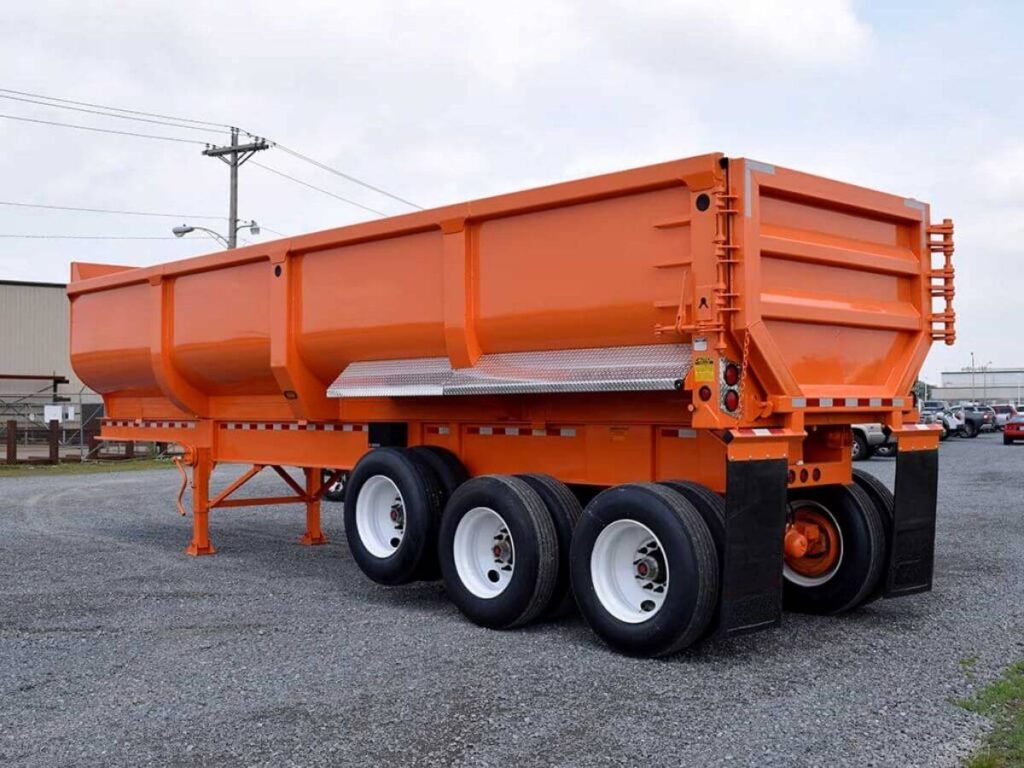
2. High-Side End Dump Trailer
A High-Side End Dump Trailer is like the big brother of the standard end dump, taller, roomier, and built to move volume. It features higher sidewalls that allow you to carry more material per trip, especially when the payload is light but bulky.
If you’re in agriculture, landscaping, or bulk commodity transport, this trailer gives you serious load efficiency without needing a larger footprint.
Specifications
- Side Height: Typically 60″ to 72″ or more
- Material: Aluminum is common to keep weight low
- Length: 35’–40′ (varies by region and use)
- Body Shape: Rectangular (maximum capacity)
- Axles: Tandem or tri-axle options
- Tarp System: Usually required for wind resistance and safety
Applications
This trailer shines when you’re moving large volumes of lighter-weight materials that would otherwise overflow a standard end dump. You’ll see high-sides frequently used in:
- Agriculture: Grain, corn, soybeans
- Landscaping & mulch operations
- Food production & bulk packaging plants
- Recyclables and low-density waste hauls
If you’re in any sector that hauls fluffy, loose, or wind-sensitive material, you’re looking at the right trailer.
Best-Suited Materials and Load Types
From experience, these trailers are ideal when you need to move volume, not just weight. Perfect for:
- Grain and corn
- Sawdust, mulch, wood chips
- Fertilizer
- Recyclables (plastic, paper, cans)
- Dry commodities and packaged goods
I once helped an ag client who was using standard dumps for corn transport, and they were constantly running short on capacity. Switching to high-sides cut their trips by 30%. That’s the kind of difference this trailer can make.
Potential Drawbacks
As with any specialty trailer, it’s not a one-size-fits-all solution.
- Wind Resistance: High profile = more drag and higher fuel use
- Stability Risks: More volume up high means a higher center of gravity
- Tarp System Required: To prevent blowouts and meet DOT regs
- Not for Heavy Loads: You’ll max out volume long before weight
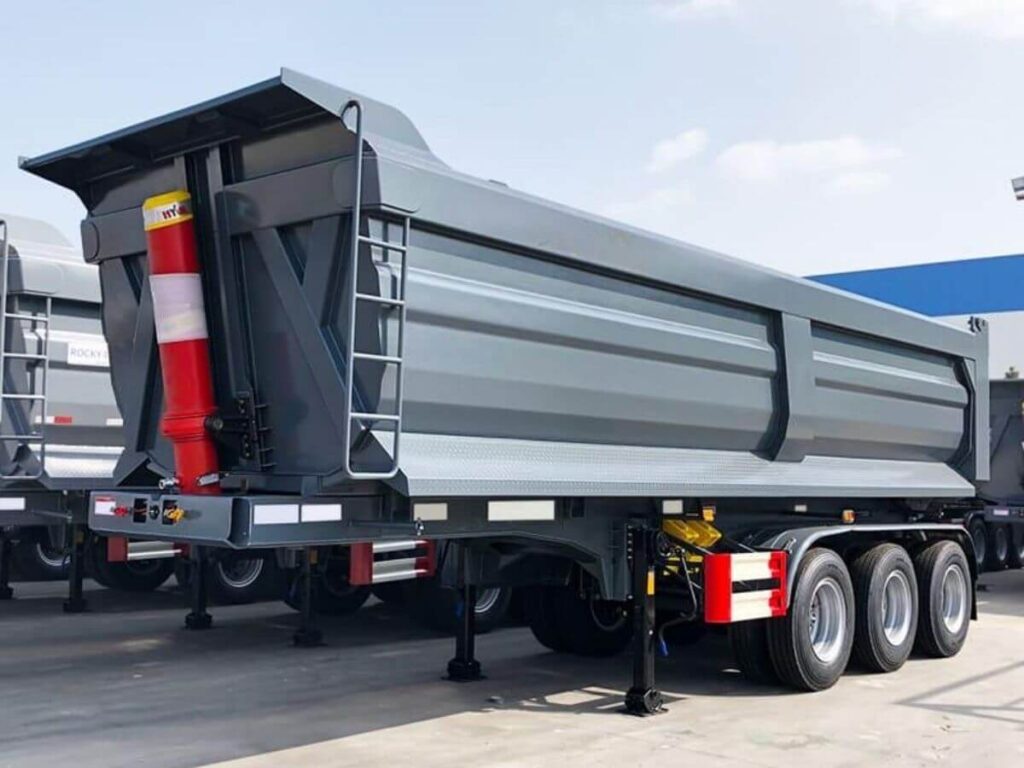
3. Side Dump Trailer
The Side Dump Trailer flips the script, literally. Instead of lifting from the back, this trailer tilts to one side to unload its contents. It’s designed for fast, safe dumping without the risk of tipping over like a traditional end dump.
I’ll never forget the first time I watched one in action on a remote site. Smooth, stable, and fast, it dumped a full load of gravel in seconds, and didn’t even flinch on uneven ground. That’s when I realized how big of a game-changer side dumps are for rough environments.
Specifications
- Dumping Direction: Right, left, or dual-side models available
- Length: 30’–40’+ depending on build
- Material: Usually steel or aluminum
- Axles: Tandem, tri, or multi-axle setups
- Hydraulics: Horizontal cylinders
- Body Shape: Tub or wedge-style design for clean emptying
Applications
If you work on sites where stability is non-negotiable, this trailer earns its keep. It performs especially well in:
- Highway and road construction
- Mining and energy sectors
- Rough, uneven, or soft terrain jobsites
- Fast-paced hauling operations where cycle time matters
It’s also great for jobs that require partial unloading across distance, ditch building, road shoulder work, etc.
Best-Suited Materials and Load Types
Side dumps are tough and versatile. Here’s what they handle best:
- Crushed rock and gravel
- Wet soil and clay
- Demolition debris
- Coal, ore, and mining byproducts
- Asphalt (in some models)
I once consulted with a contractor on a mine site who kept tipping standard end dumps. We switched them over to side dumps, zero incidents since. It saved them repairs, delays, and a lot of stress.
Potential Drawbacks
Of course, no trailer is perfect. And side dumps have their trade-offs too.
- Lower capacity than high-sided or rectangular end dumps
- Material placement isn’t precise, not ideal if you need controlled, even spread
- More moving parts = more maintenance
- Takes up more lateral space to unload safely
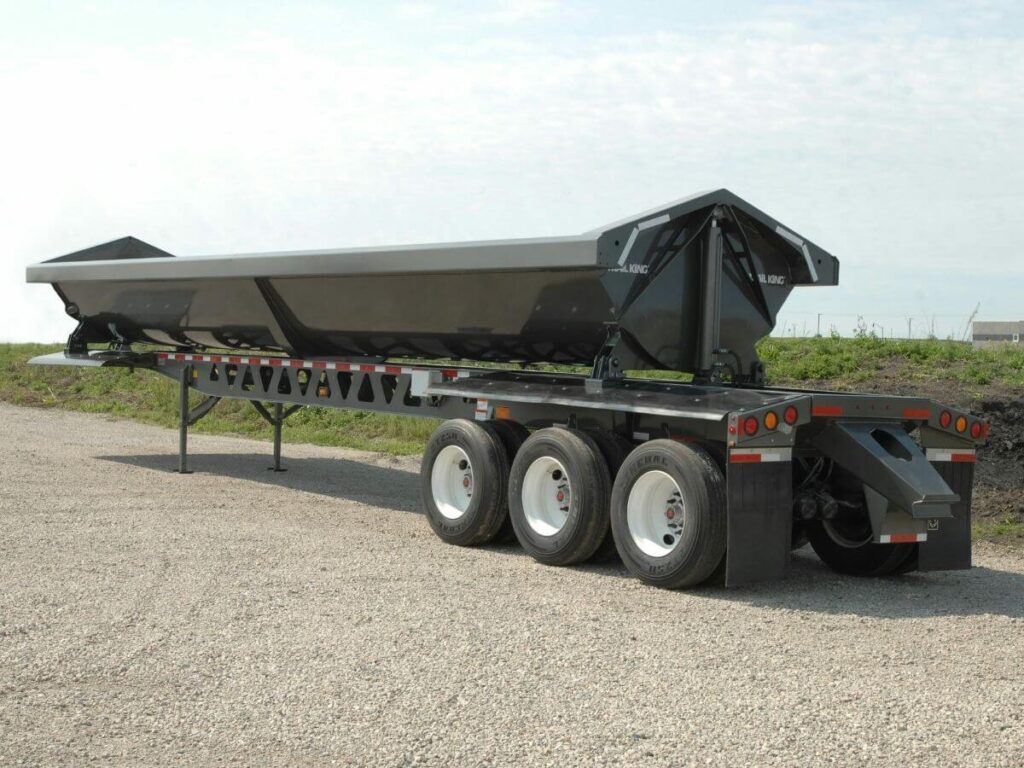
4. Frame-Type End Dump Trailer
The Frame-Type End Dump Trailer is built like a tank. It’s designed with a full-length frame underneath the tub, giving it extra support, strength, and rigidity. This is the trailer you bring when the job demands maximum durability, no excuses.
I’ve been on demolition jobs where we were loading boulders, rebar, and concrete chunks all day long. A frameless trailer wouldn’t have lasted. But this beast? Took it all, day after day.
Specifications
- Chassis: Full-frame, heavy-duty steel
- Length: Typically 28’–34′
- Material: Mostly steel construction
- Axles: Tandem or tri-axle setups
- Dumping Direction: Rear (vertical lift)
- Suspension: Often spring or heavy-duty air ride
Applications
This trailer is built for abuse and extreme environments. You’ll find it at home in:
- Demolition sites
- Quarries and mining operations
- Heavy construction and industrial cleanups
- Hauling scrap, rock, or oversized debris
If your load is rough on gear, this is your safest bet.
Best-Suited Materials and Load Types
Frame-type trailers excel when loads are heavy, dense, and unforgiving. Ideal for:
- Broken concrete
- Asphalt chunks
- Large boulders or rocks
- Scrap metal
- Slag and heavy industrial waste
One of our clients in the scrap industry switched to frame-types after cracking two frameless units in under a year. The frame-type lasted 5+ years with minimal downtime. Sometimes, overbuilding is just a smart business.
Potential Drawbacks
- Heavier tare weight = lower payload and higher fuel use
- Reduced maneuverability compared to frameless models
- Can be more expensive upfront
- Not ideal for lightweight or high-volume loads
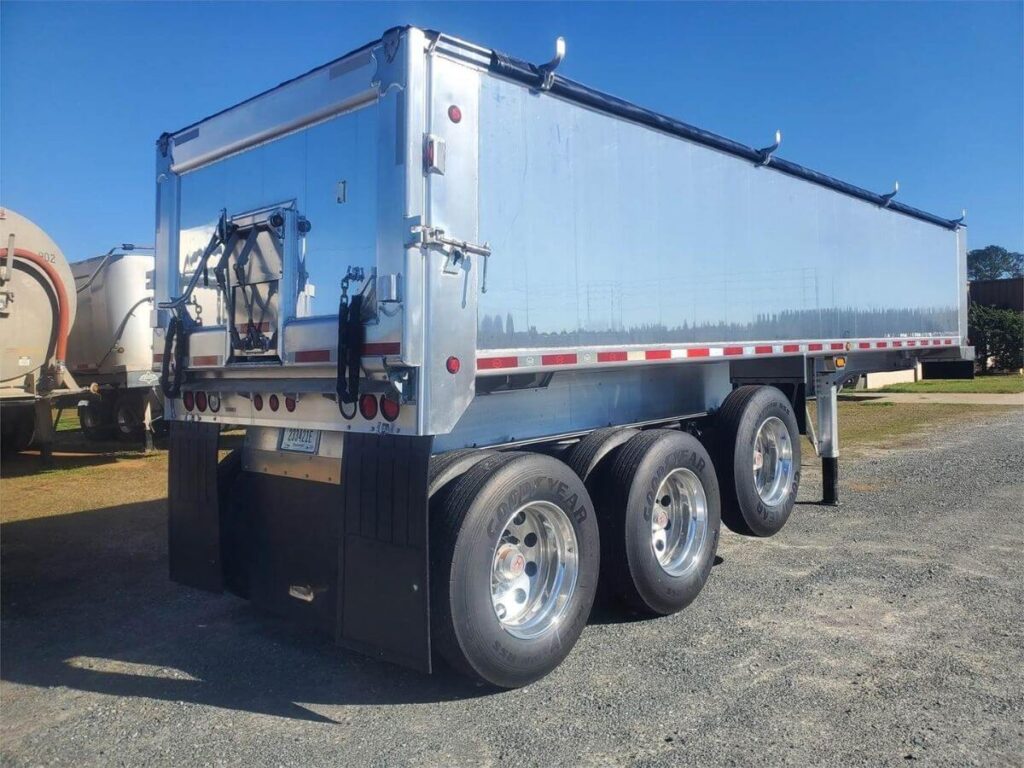
5. Frameless End Dump Trailer
The Frameless End Dump Trailer is the lighter, more agile cousin of the frame-type. It ditches the heavy underframe, relying on the strength of the tub and suspension system. What you lose in brute force, you gain in payload capacity and fuel savings.
I remember the first time we switched to frameless. We were hauling gravel on a long route, and I noticed right away—we were pulling more weight with less fuel. By the end of the week, the numbers didn’t lie. It paid for itself in efficiency.
Specifications
- Chassis: No full-length frame
- Material: Aluminum or lightweight steel
- Length: Typically 34’–40’+
- Axles: Tandem, tri, or spread axle
- Dumping Direction: Rear (telescopic hoist)
- Tare Weight: Significantly lighter than frame-type models
Applications
Frameless trailers are a favorite in operations where volume and efficiency matter more than brute durability. You’ll see them in:
- Construction aggregates
- Sand and gravel hauling
- Agriculture and fertilizer transport
- Bulk material delivery over long distances
If your team is clocking serious miles, this trailer can stretch your margins.
Best-Suited Materials and Load Types
You want to pair this trailer with non-abrasive, free-flowing loads, like:
- Sand and gravel
- Topsoil
- Dry fertilizer
- Grain and agricultural byproducts
- Light demolition debris
One of my clients in the Midwest shifted their entire fleet to frameless to increase payloads during harvest season. They’re now hauling up to 2 extra tons per trip without exceeding axle limits.
Potential Drawbacks
Now, let’s talk real. Frameless isn’t for everyone.
- Less structural rigidity = more flex under stress
- Not ideal for off-road or uneven terrain
- Higher tipping risk on unstable ground
- Can’t take the same abuse as a frame-type
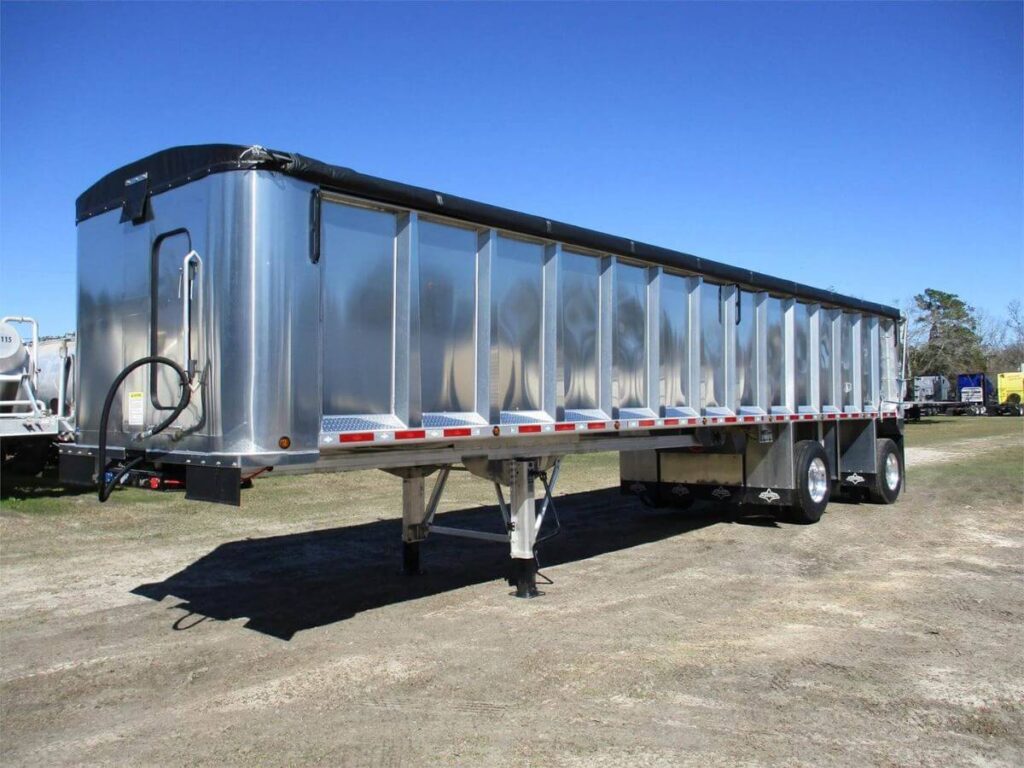
6. Half-Round End Dump Trailer
The Half-Round End Dump Trailer is known for its strength, simplicity, and efficient unloading. With a curved, tub-like body and no corners, materials slide out clean, fast and with minimal hang-up. It’s especially valuable when you’re hauling sticky, abrasive, or heavy materials that don’t play nice with flat walls.
I’ve seen these trailers go where box-style ones get jammed up. The load slides out smooth, even when it’s wet clay or fresh asphalt. Fewer clogs, fewer headaches.
Specifications
This trailer’s design makes it a powerhouse in tough material handling. Here’s what you should know:
- Body Shape: Rounded bottom with high sides
- Material: High-strength steel (often AR450/500)
- Length: Usually 32’–39′
- Axles: Tandem or tri-axle
- Dumping Direction: Rear
- Unloading Efficiency: Excellent for sticky or dense materials
Applications
The half-round is built for the kind of work that beats up your equipment. You’ll find it most commonly used in:
- Heavy construction and road building
- Demolition cleanup
- Quarries and aggregate pits
- Municipal and infrastructure projects
Best-Suited Materials and Load Types
Thanks to its curved design, it naturally resists material buildup. That makes it ideal for:
- Asphalt
- Wet clay and soil
- Riprap and large stone
- Concrete rubble
- Slag and dense industrial waste
At Rhinotrail, we manufacture half-round end dump trailers with extra-thick floors and reinforced hoists because we know what these trailers go through. Whether you’re hauling hot mix or sharp-edged rock, you need a trailer that holds up—and empties out.
Potential Drawbacks
As good as they are at unloading, half-rounds do have a few limitations:
- Lower overall volume compared to square-box designs
- Harder to load with some equipment (curved floor = less flat space)
- Less stable when dumped on a slope
- Not ideal for light, fluffy materials
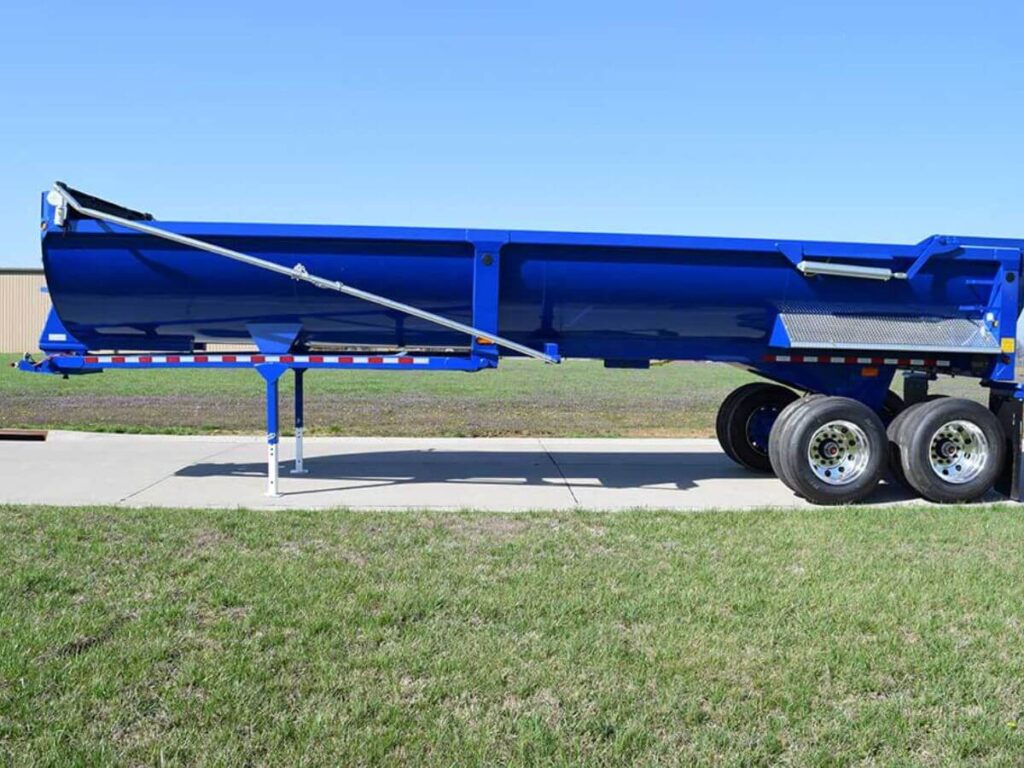
7. Square-Box End Dump Trailer
The Square-Box End Dump Trailer is all about maximum capacity. Built with straight sides and a flat floor, it gives you more interior volume than a half-round, perfect for hauling light, bulky loads that need space more than strength.
I’ve worked with ag haulers who swear by square-box trailers during harvest. One guy told me, “It’s like a rolling storage bin, we pack it tight and move more every trip.” That’s exactly what it’s built for.
Specifications
When volume matters more than brute force, these are the specs to watch:
- Body Shape: Square/rectangular with flat floor
- Material: Aluminum or steel
- Length: Typically 35’–40’+
- Axles: Tandem, tri-axle, or spread axle
- Dumping Direction: Rear
- Volume Capacity: Higher than half-round trailers
Applications
- Agriculture and grain transport
- Compost and mulch hauling
- Recyclables (cardboard, paper, plastic)
- Waste collection
- Food processing and packaging industries
Anywhere high volume meets high frequency, this trailer fits in.
Best-Suited Materials and Load Types
This trailer handles anything light and expansive that benefits from square corners and tall sides:
- Grain, corn, soybeans
- Wood chips, mulch
- Recyclables and plastics
- Poultry litter and organic waste
- Packaged or bagged materials on pallets
If you’re looking to reduce trips and load more volume without pushing your weight limits, the square box is your go-to.
Potential Drawbacks
Of course, with more space comes a few challenges:
- Material hang-up risk (corners = clogs with sticky loads)
- Not as strong as half-rounds for rough or abrasive materials
- Slightly higher center of gravity = more caution needed when dumping
- Less ideal for dense or jagged debris
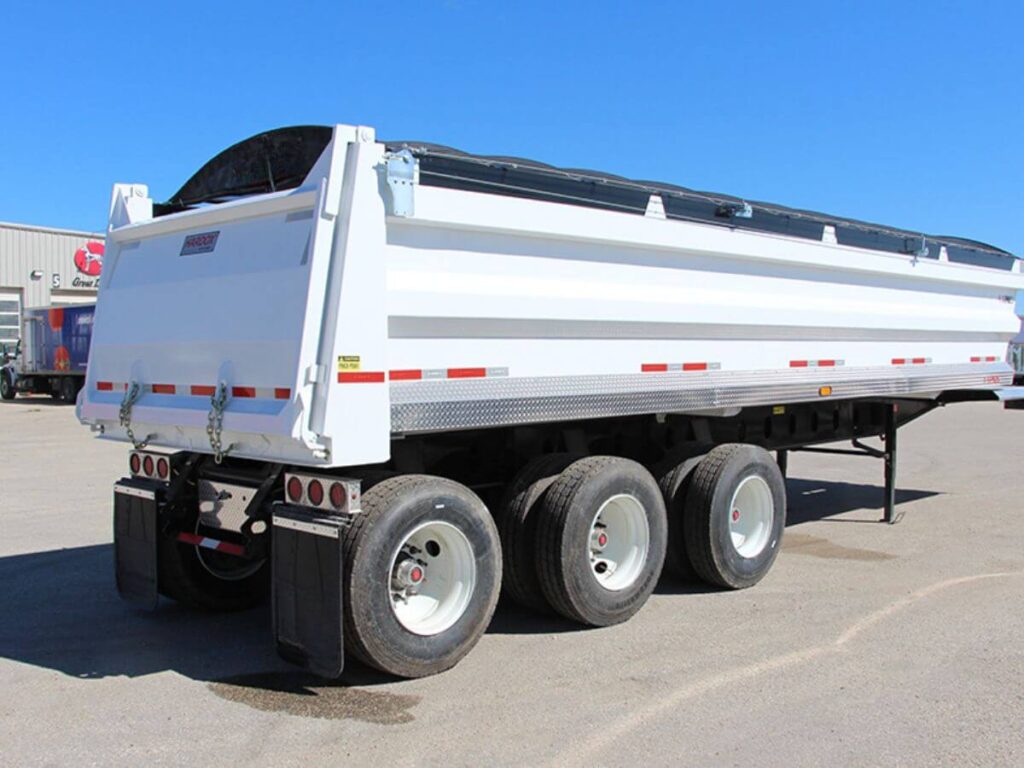
8. Steel End Dump Trailer
The Steel End Dump Trailer is your go-to when toughness takes priority. Built from high-tensile steel, this trailer is made to withstand serious abuse, sharp, heavy, and abrasive loads that tear up lighter builds.
I’ve seen steel trailers come back from jobs that would’ve shredded aluminum in a day. One customer told me, “We don’t baby our equipment, and this thing just keeps showing up to work.” That’s the kind of confidence steel gives you.
Specifications
- Material: High-tensile steel (often AR450/AR500)
- Length: Typically 28’–34′
- Axles: Tandem or tri-axle
- Dumping Direction: Rear
- Body Shape: Half-round or square-box styles
- Weight: Heavier tare, but built for punishment
Applications
- Demolition and scrap hauling
- Mining and quarry operations
- Heavy construction
- Industrial waste and metal recycling
If your business moves the kind of load that breaks things, steel is your insurance policy.
Best-Suited Materials and Load Types
This trailer is made to handle the worst of the worst. Ideal for:
- Scrap metal
- Broken concrete
- Asphalt
- Large boulders or rocks
- Heavy industrial waste and slag
At Rhinotrail, we manufacture steel end dump trailers for companies that operate in the harshest conditions. Our builds focus on structural reinforcement, high-wear resistance, and extended life cycles, so your fleet lasts longer, and downtime stays low.
Potential Drawbacks
The strength comes with a few compromises:
- Heavier tare weight = lower legal payload
- Higher fuel consumption on long hauls
- Can corrode faster than aluminum without proper maintenance
- Not ideal for light or fluffy materials due to added weight
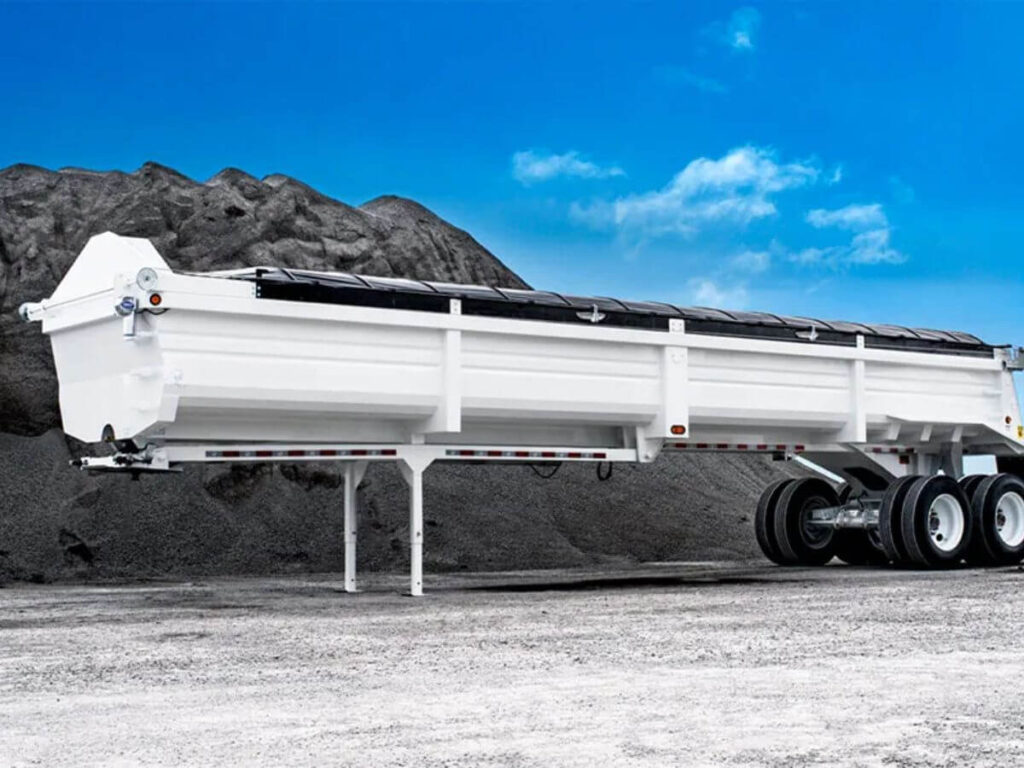
9. Aluminum End Dump Trailer
The Aluminum End Dump Trailer is all about lightweight efficiency. Built for high-volume, lower-impact hauls, it gives you the advantage of more payload per trip without compromising performance on the road.
I remember the first time I ran an aluminum trailer on a long grain haul. We loaded more, burned less fuel, and hit our drop-off time early. After that, it was hard to justify going back to anything heavier for those types of loads.
Specifications
These trailers are designed for lightness, speed, and clean operation. Key features include:
- Material: Aluminum (corrosion-resistant, lightweight)
- Length: 35’–40’+
- Axles: Tandem or tri-axle
- Body Shape: Often square-box for max capacity
- Dumping Direction: Rear
- Tare Weight: 2,000–3,000 lbs lighter than steel counterparts
Applications
Aluminum end dumps are ideal when your operation prioritizes volume, fuel efficiency, and cleaner materials. You’ll find them used heavily in:
- Agriculture and grain transport
- Food production and packaging
- Bulk mulch, compost, or fertilizer hauling
- Landscaping and clean fill operations
If you’re doing long-haul runs with DOT weight limits in play, aluminum gives you the edge in capacity.
Best-Suited Materials and Load Types
This trailer is best for non-abrasive, low-impact materials, such as:
- Grain, corn, soybeans
- Dry fertilizer
- Wood chips and sawdust
- Compost and mulch
- Food-grade or packaged goods
Potential Drawbacks
While efficiency is unbeatable, there are some trade-offs to keep in mind:
- Not built for heavy-impact loads (steel is better for that)
- More prone to denting or damage from rough handling
- Higher upfront cost than basic steel models
- Limited durability in harsh demolition or scrap environments
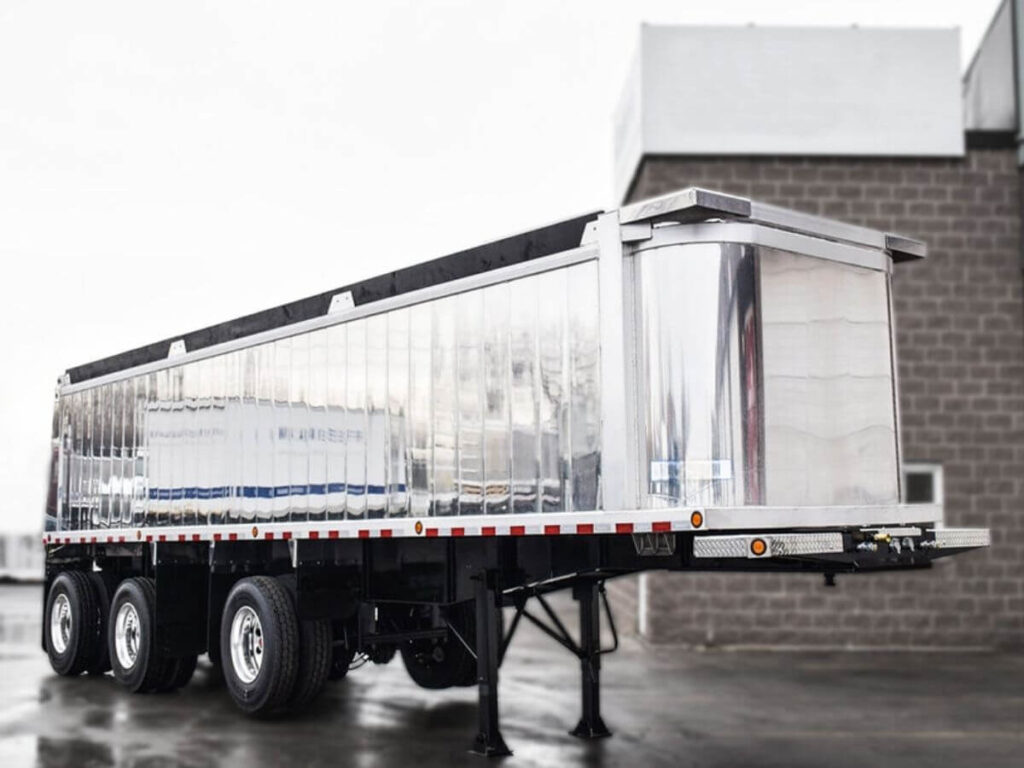
10. Multi-Axle End Dump Trailer
The Multi-Axle End Dump Trailer is designed to handle heavier loads legally and safely. With three or more axles, this trailer offers better weight distribution, increased payload capacity, and improved road stability, especially important in regions with strict axle load regulations.
I once worked with a logistics manager in the Northeast who was getting hit with overweight fines every month. After switching to multi-axle dumps, not only did those fines vanish, but he started running heavier loads legally, saving time and money.
Specifications
If your fleet operates under DOT scrutiny or hauls heavy loads often, these are the specs to consider:
- Axles: 3, 4, 5, or more (depending on state laws)
- Length: Varies—often 34’–42′
- Material: Steel or aluminum
- Dumping Direction: Rear
- Body Shape: Available in square-box or half-round
- Load Rating: Significantly higher than standard tandem trailers
Applications
This trailer is ideal for businesses that push maximum legal payloads while staying compliant. Common applications include:
- Asphalt paving and road construction
- Heavy construction hauling
- Mining and bulk aggregate transport
- Municipal or state DOT projects
If you’re in a region like Michigan, Pennsylvania, or parts of Canada, multi-axle isn’t a luxury. It’s a necessity.
Best-Suited Materials and Load Types
These trailers are built to carry more without tipping or triggering violations. Ideal for:
- Asphalt and hot mix
- Dense aggregate
- Wet or compacted soil
- Large-volume municipal contracts
- Any load where weight limits are pushed to the edge
They’re especially useful when you need to move more with fewer trips, and your team can’t afford fines, rework, or downtime.
Potential Drawbacks
Of course, with more axles comes more complexity:
- Higher upfront cost (more tires, more components)
- Tighter turning radius—less agile in small job sites
- More maintenance across multiple axles and brakes
- Requires careful planning for permit and regulation compliance
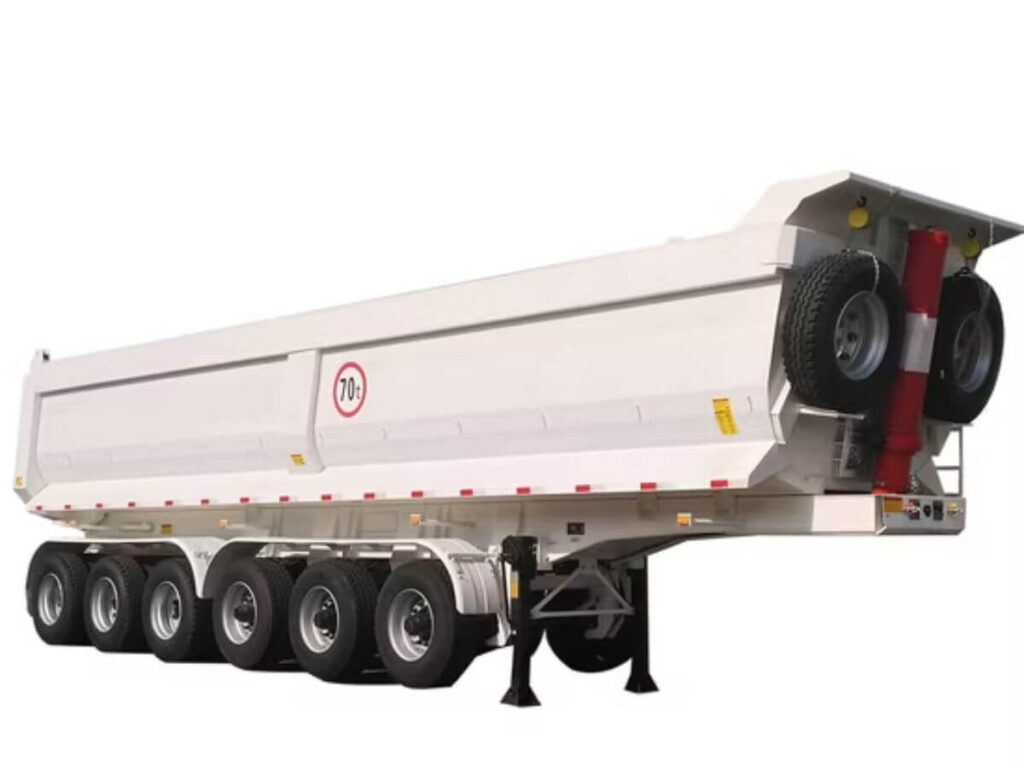
Conclusion
That muddy job site? We never made that mistake again. The right trailer changed everything—faster jobs, fewer delays, and more profit.
Now you know what each end dump trailer does, how it works, and when to use it. Whether you’re in construction, ag, or logistics—choosing right isn’t optional. It’s mission-critical.
So what’s stopping you? Start optimizing your fleet today.
Let’s talk. Contact us today and get the right trailer for your business. We’re here to help you haul smarter—not harder.


